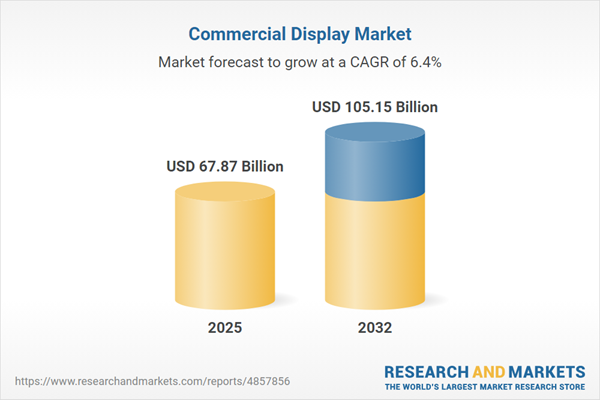Speak directly to the analyst to clarify any post sales queries you may have.
The commercial display market is undergoing rapid transformation as enterprises prioritize adaptive visual communication solutions to streamline collaboration, drive workforce engagement, and support evolving operational priorities in modern work environments.
Market Snapshot: Commercial Display Market Size and Growth
The commercial display market was valued at USD 63.78 billion in 2024, with projected growth to USD 67.87 billion by 2025 and a compound annual growth rate of 6.44%. Forecasts anticipate the sector reaching USD 105.15 billion by 2032. Key growth drivers include adoption of digital signage and interactive displays, alongside organizational investments in reliable platforms for enterprise communication. Both public and private sector entities are modernizing their display infrastructures to enhance organizational communication and meet shifting operational expectations. Ongoing advances in hardware and management software are supporting workflow optimization and more responsive executive decision-making.
Scope & Segmentation: Insights for the Commercial Display Market
This research delivers targeted insights into the critical segments informing technology investments and compliance strategies. Each segment highlights core technology selection, deployment options, and regional considerations shaping enterprise purchasing decisions:
- Display Technologies: E-paper, LCD (including IPS, TN, and VA), Direct View, Micro LED, Mini LED, and OLED provide specific benefits in terms of durability, clarity, and interactivity, serving demanding applications across industries from healthcare to public spaces.
- Panel Sizes: Displays under 32 inches are optimal where space and targeted viewing are essential; larger panels above 65 inches maximize impact in lobbies, boardrooms, or public areas.
- End Users: Corporations, healthcare providers, educational institutions, transport operators, hospitality venues, and retailers utilize commercial displays to boost productivity, address compliance obligations, and engage specific audiences.
- Resolutions: HD, Full HD, Ultra HD, and 8K resolution choices enable organizations to select the right clarity level for scenarios from focused presentations to large-scale information delivery.
- Brightness Levels: Adjustable brightness solutions ensure consistent visibility across settings such as well-lit offices, outdoor venues, and specialty environments.
- Mounting Types: Flexible mounting options, including ceiling, wall, table, and floor models, simplify integration within both new and legacy infrastructures, enabling efficient space utilization.
- Geographic Regions: The Americas, Europe, Middle East and Africa, and Asia-Pacific each exhibit distinct adoption trends, regulatory environments, and technology maturity, helping organizations refine their procurement and deployment strategies.
- Industry Players: Major manufacturers such as BOE Technology Group, LG Display, Samsung Display, Innolux Corporation, AU Optronics, TCL China Star Optoelectronics, Sharp Corporation, Japan Display, Tianma Microelectronics, and Visionox Technology influence innovation cycles and procurement standards globally.
Commercial Display Market: Key Takeaways for Senior Leaders
- Integration of artificial intelligence and IoT into display technologies enables automated, adaptive content delivery and enhances system efficiency across distributed environments.
- Service-led procurement models align technology deployment with business needs and support ongoing asset management.
- Prioritizing sustainability in display technology—to ensure energy efficiency and recyclability—helps organizations meet compliance goals and environmental objectives.
- Aligning display upgrades with financial planning and regulatory compliance minimizes operational disruption and supports continuity during modernization efforts.
- Interactive solutions promote collaboration and real-time information sharing in environments like education and healthcare, supporting measurable productivity benefits.
- Ensuring secure content delivery and network integration across multiple locations is vital for maintaining system availability and performance consistency.
Tariff Impact: Navigating Regulatory and Supply Chain Changes
Upcoming US tariffs in 2025 have prompted organizations to scrutinize supply chains for resilience, with senior leaders using advanced analytics and scenario planning to manage procurement risk and sustain operational continuity in a changing regulatory landscape.
Methodology & Data Sources
This analysis is grounded in executive interviews, comprehensive sector surveys, and direct input from leading manufacturers and end users. Figures and qualitative findings are based on proprietary research validated by market experts to ensure objectivity and strategic relevance.
Why This Report Matters for Senior Leaders
- Enhances procurement strategies and reinforces supply chain resilience in the context of rapidly changing commercial display market dynamics.
- Enables data-driven digital transformation and supports formation of enduring technology partnerships to drive organizational growth.
- Prepares decision-makers to adapt proactively to regulatory shifts and technological advances with confident, well-informed strategies.
Conclusion
This report equips senior leaders with actionable insights to accelerate digital transformation, drive enterprise resilience, and maintain a competitive edge in the evolving commercial display industry.
Additional Product Information:
- Purchase of this report includes 1 year online access with quarterly updates.
- This report can be updated on request. Please contact our Customer Experience team using the Ask a Question widget on our website.
Table of Contents
3. Executive Summary
4. Market Overview
7. Cumulative Impact of Artificial Intelligence 2025
Companies Mentioned
The companies profiled in this Commercial Display market report include:- BOE Technology Group Co., Ltd.
- LG Display Co., Ltd.
- Samsung Display Co., Ltd.
- Innolux Corporation
- AU Optronics Corp.
- TCL China Star Optoelectronics Technology Co., Ltd.
- Sharp Corporation
- Japan Display Inc.
- Tianma Microelectronics Co., Ltd.
- Visionox Technology Co., Ltd.
Table Information
| Report Attribute | Details |
|---|---|
| No. of Pages | 181 |
| Published | November 2025 |
| Forecast Period | 2025 - 2032 |
| Estimated Market Value ( USD | $ 67.87 Billion |
| Forecasted Market Value ( USD | $ 105.15 Billion |
| Compound Annual Growth Rate | 6.4% |
| Regions Covered | Global |
| No. of Companies Mentioned | 11 |









